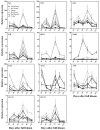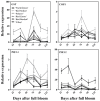Differences among the Anthocyanin Accumulation Patterns and Related Gene Expression Levels in Red Pears
- PMID: 30995732
- PMCID: PMC6524040
- DOI: 10.3390/plants8040100
Differences among the Anthocyanin Accumulation Patterns and Related Gene Expression Levels in Red Pears
Abstract
Differences in coloration exist among red pear cultivars. Here, we selected six red pear cultivars with different genetic backgrounds to elucidate the characteristics of fruit pigmentation. We detected anthocyanin contents and the expression levels of anthocyanin synthesis-related genes in these cultivars at different stages of fruit development. The anthocyanin contents of all six cultivars showed a rise-drop tendency. Principal component and hierarchical cluster analyses were used to distinguish the types of cultivars and the genes crucial to each anthocyanin accumulation pattern. The six cultivars were divided into three groups. Red Zaosu were clustered into one group, Red Sichou and Starkrimson into another group, and Palacer, Red Bartlett, and 5 Hao clustered into a third group. The expression levels of F3H, UFGT2, MYB10, and bHLH3 were similar among the differential coloration patterns of the six cultivars, suggesting a critical and coordinated mechanism for anthocyanin synthesis. Anthocyanin transporters (GST) and light-responsive genes, such as COP1, PIF3.1, and PIF3.2 played limited roles in the regulation of anthocyanin accumulation. This study provides novel insights into the regulation of anthocyanins synthesis and accumulation in red pears.
Keywords: anthocyanin; coloration; gene expression; red pear.
Conflict of interest statement
The authors declare that the research was conducted in the absence of any commercial or financial relationships that could be construed as a potential conflict of interest.
Figures






Similar articles
-
Expression differences of anthocyanin biosynthesis genes reveal regulation patterns for red pear coloration.Plant Cell Rep. 2015 Feb;34(2):189-98. doi: 10.1007/s00299-014-1698-0. Epub 2014 Oct 18. Plant Cell Rep. 2015. PMID: 25323492
-
The crucial role of PpMYB10.1 in anthocyanin accumulation in peach and relationships between its allelic type and skin color phenotype.BMC Plant Biol. 2015 Nov 18;15:280. doi: 10.1186/s12870-015-0664-5. BMC Plant Biol. 2015. PMID: 26582106 Free PMC article.
-
Anthocyanin accumulation differences in European pears caused by Phytochrome-interacting factor 3 (PcPIF3) promoter mutations under UV-B.J Adv Res. 2025 May 13:S2090-1232(25)00303-0. doi: 10.1016/j.jare.2025.05.010. Online ahead of print. J Adv Res. 2025. PMID: 40373962
-
PbRVE6 Promotes Anthocyanins Accumulation in Pear Fruit Peel by Regulating Key Biosynthetic Genes.Physiol Plant. 2024 Nov-Dec;176(6):e14597. doi: 10.1111/ppl.14597. Physiol Plant. 2024. PMID: 39479753
-
REVEILLE Transcription Factors Contribute to the Nighttime Accumulation of Anthocyanins in 'Red Zaosu' (Pyrus bretschneideri Rehd.) Pear Fruit Skin.Int J Mol Sci. 2020 Feb 27;21(5):1634. doi: 10.3390/ijms21051634. Int J Mol Sci. 2020. PMID: 32120999 Free PMC article.
Cited by
-
Chromosome-level genome assemblies of Musa ornata and Musa velutina provide insights into pericarp dehiscence and anthocyanin biosynthesis in banana.Hortic Res. 2024 Mar 14;11(5):uhae079. doi: 10.1093/hr/uhae079. eCollection 2024 May. Hortic Res. 2024. PMID: 38766534 Free PMC article.
-
Dynamic Changes of the Anthocyanin Biosynthesis Mechanism During the Development of Heading Chinese Cabbage (Brassica rapa L.) and Arabidopsis Under the Control of BrMYB2.Front Plant Sci. 2020 Dec 23;11:593766. doi: 10.3389/fpls.2020.593766. eCollection 2020. Front Plant Sci. 2020. PMID: 33424889 Free PMC article.
-
PbMYB120 Negatively Regulates Anthocyanin Accumulation in Pear.Int J Mol Sci. 2020 Feb 24;21(4):1528. doi: 10.3390/ijms21041528. Int J Mol Sci. 2020. PMID: 32102306 Free PMC article.
-
Triacontanol Promotes the Fruit Development and Retards Fruit Senescence in Strawberry: A Transcriptome Analysis.Plants (Basel). 2020 Apr 10;9(4):488. doi: 10.3390/plants9040488. Plants (Basel). 2020. PMID: 32290080 Free PMC article.
-
Integrative HPLC profiling and transcriptome analysis revealed insights into anthocyanin accumulation and key genes at three developmental stages of black rice (Oryza sativa. L) caryopsis.Front Plant Sci. 2023 Aug 30;14:1211326. doi: 10.3389/fpls.2023.1211326. eCollection 2023. Front Plant Sci. 2023. PMID: 37727854 Free PMC article.
References
-
- Tao P., Shu Q., Wang J.J., Zhang W.B. Present situation and prospect of research and utilization on red pear germplasm resources. Southwest China J. Agric. Sci. 2004;17:409–412.
-
- Dussi M.C., Sugar D., Wrolstad R.E. Characterizing and quantifying anthocyanins in red pears and the effect of light quality on fruit color. J. Am. Soc. Hortic. Sci. 1995;120:785–789. doi: 10.21273/JASHS.120.5.785. - DOI
-
- Dayton D.F. The pattern and inheritance of anthocyanin distribution in red pears. J. Am. Soc. Hortic. Sci. 1996;89:110–116.
-
- Xiao C., Jiaming L.I., Yao G.F., Liu J., Hu H.J. Characteristics of components and contents of anthocyanin in peel of red-skinned pear fruits from different species. J. Nanjing Agric. Univ. 2004;37:60–66.
LinkOut - more resources
Full Text Sources
Research Materials

